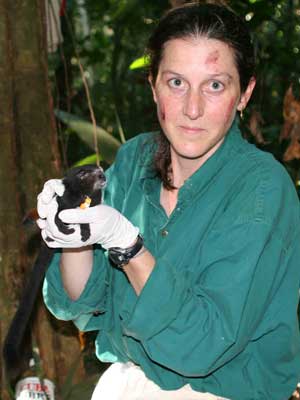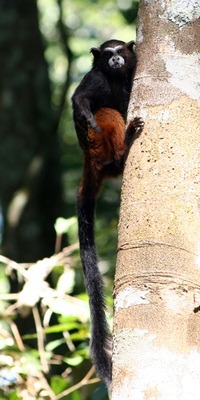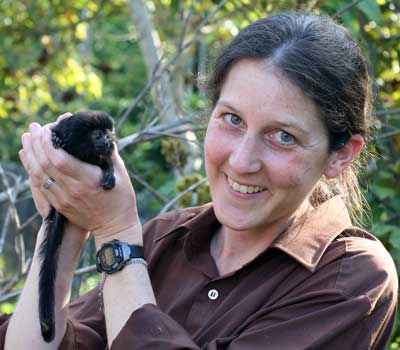Leila Porter, an NIU professor of anthropology, is up to some serious monkey business.
She spent last summer in a Bolivian rain forest, tracking and catching some very peculiar primates known as saddle-back tamarins, before releasing them back into the wild.
The squirrel-sized monkeys, from the family Callitrichidae, are closely related to the more well-known lion tamarins, distinctive for their faces encircled by thick manes and often found in zoos.
Porter zeroed in on the saddle-back variety because they are relatively easy to catch and because of their highly unusual social system, which is of interest to scientists who study evolution. The system is built around cooperative breeding, whereby one breeding female typically has a set of twins, and the young are raised by a group of about seven adult monkeys.
“Some social insects, such as bees, have this cooperative breeding pattern, but it’s peculiar for a mammal and very peculiar for a primate,” says Porter, who has been studying saddle-backs since 1997. “Among primates, extensive cooperative breeding is only seen in Callitrichids and in humans. For example, in some human cultures, grandmothers play an extensive role in rearing their grandchildren.”
Now Porter’s research on the monkeys is receiving a major boost from the prestigious Leakey Foundation, which aims to increase understanding of human origins, evolution and behavior. The foundation awarded a $22,000 grant to support a comprehensive study of the animals in the wild, headed by Porter, University of Texas at Austin anthropologist Anthony Di Fiori (who runs a specialized genetics lab) and Wendy Erb of Lehman College, City University of New York.
The study aims to shed light on familial relationships among the monkeys and determine why and how the animals practice cooperative breeding.
“First, we want to find out who’s helping raise the infants – is it the father, the siblings or non-relatives?” Porter says. “The latter would require the most explaining because, according to one widely accepted hypothesis in evolutionary theory, individuals typically help raise their kin.”
Non-relatives could be assisting with child rearing as a form of practice for when they have their own offspring, or possibly as a means of courtship, with males demonstrating that they would make good fathers.
Then again, it might be that some saddle-backs just have a more helpful personality than others. There are at least 10 hypotheses to test, Porter says.
Working in Bolivia with colleagues from other universities and NIU students, Porter has collected DNA samples from numerous groups of saddle-back tamarins. In fact, three of her past students – Nadia Lopez, Ileana Diaz and Colin Jackson – have helped collect data on tamarins and conducted their master’s theses on monkeys at Porter’s field site. This summer, Porter and NIU graduate student Sylvia Orellana will travel to Bolivia to train a team of Bolivians on how to collect more data.
“One reason I chose to study saddle-back tamarins is because they are naturally curious, so their response is not to run away but rather to check you out,” Porter says. “Within a matter of weeks, they’ll accept a person trekking in the forest alongside them.”
The monkeys are not among the brightest creatures, the NIU anthropologist adds.
“They don’t naturally encounter bananas in the forest, but they quickly become fond of the ones we leave out. Then, using bananas as bait, we set out traps that have 10 little compartments, and each has a door with a string. We can pull the string from a blind about 15 feet away as the monkeys enter the trap. Luckily, they don’t really notice what has happened to their neighbors, so you can actually catch a whole group this way.”
The animals’ DNA samples will be studied in Di Fiori’s laboratory to determine kinship.
But even DNA matches can be tricky business because researchers have previously discovered genetic chimerism in saddle-backs. A chimera is an animal that has two or more populations of genetically distinct cells. (The term comes from the Greek mythological creature Chimera, whose body was a mix of body parts from a lion, a serpent and a goat.)
Porter’s study could also shed more light on this trait among the saddle-backs.
“They always have twins, and it turns out twin saddle-back tamarins swap some DNA while in the womb, so they become chimeras,” Porter says. “In humans, chimerism is extremely rare – although you sometimes see it on crime-investigation shows as it adds a complicated twist for the detectives to figure out – but in my little monkeys, it’s common.”
Researchers know chimerism exists within the animals’ blood cells; less is known about whether it is evident in reproductive cells.
“If chimerism exists in their reproductive cells, a male saddle-back might have the sperm of his brother. This makes things crazy, because it would be difficult to determine which brother fathered an offspring,” Porter says.
“They are pretty wild little monkeys,” she adds.



